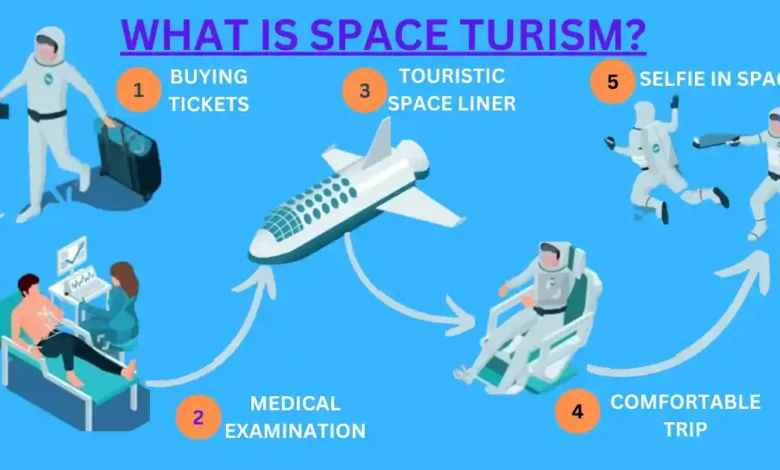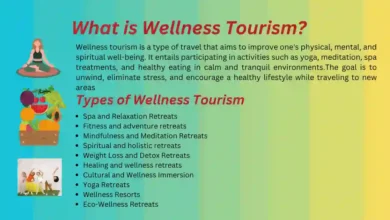
Space tourism is a fascinating reality at a time when the limits of discovery are continually being pushed. The idea of private individuals traveling to the stars, formerly relegated to science fiction, is now conceivable. The development, varieties, advantages, and difficulties of space tourism are briefly discussed in this article. We shed light on the fascinating yet complex environment that creates this revolutionary industry as we navigate the galaxy of suborbital trips, orbital aspirations, and moon dreams. Space tourism is an intriguing phenomenon that has the potential to change how humans interact with the universe, from arousing interest in STEM areas to arousing worries about environmental effects.
Space Tourism
Space tourism is the term used to describe the commercial activity of transporting private individuals into space for leisure, adventure, or amusement. Space tourism concentrates on providing ordinary people with the chance to experience space flight and see the Earth from space, in contrast to conventionally-funded government space missions when astronauts carry out other activities or conduct scientific research.
History of Space Tourism
The history of space tourism began long ago when individuals first envisioned traveling to space for entertainment. This concept grew more tangible in the 1990s, and a group was formed to discuss it. Then, in the early 2000s, a contest spurred groups to build miniature spacecraft capable of reaching the outer limits of space. One team triumphed and demonstrated that common people could travel to space.
After that, businesses like Virgin Galactic and SpaceX began developing tourist-friendly spacecraft. Recent events include Jeff Bezos and others taking off in rockets, as well as SpaceX transporting passengers to the space station. It appears that space travel is becoming a reality and that more people will likely experience it in the future.
Types of Space Tourism
There are three types of Space tourism.
- Suborbital
- Orbital tourism
- Lunar Tourism
Suborbital Tourism
Suborbital travel is similar to a brief trip up and down to the brink of space. People briefly become weightless and get to view the Earth from a great height. Suborbital flights are being developed by organizations like Virgin Galactic and Blue Origin.
Orbital Tourism
This is a lengthy journey that involves numerous orbits of the Earth. They can stay in space for days or even weeks, experiencing longer periods of weightlessness and taking in breathtaking views. This kind of tourism hasn’t yet taken place and is currently in the planning stages.
Lunar Tourism
Some businesses have discussed taking travelers on a tour of the moon. This vacation would be extremely expensive and sophisticated, yet it is still in the future.
Advantages of Space Tourism
Space travel has a number of advantages for both individuals and society at large. The key advantages include the following.
Education and Scientific Inspiration
Space travel can pique people’s interest in STEM areas, which include science, technology, engineering, and mathematics. The experience of viewing Earth from orbit can help people understand our planet’s fragility better, which might improve their support for environmental conservation initiatives.
Technological Innovation
The growth of space tourism necessitates technological advancements in a number of areas, including spaceship design, propulsion technology, life support technology, and more. These developments may have a domino effect, advancing various sectors and industries.
Economic Opportunities
In areas where launch sites, training facilities, and related infrastructure are created, the space tourism industry has the potential to provide jobs and foster economic growth. This might open up positions for engineers, technicians, pilots, waiters, and more.
Reduced Space Access Costs
As the space tourism sector grows and develops, it may help to bring down the price of entering space. Governments, academic institutes, and commercial entities may ultimately be able to afford space exploration and research thanks to innovations and money-saving techniques created for space tourism.
Public-Private Partnership
Space tourism can encourage government and commercial sector cooperation, resulting in more effective and creative space endeavors. The advancement of technology and space exploration may be accelerated by this cooperative framework.
Diversification of Space Activities
The variety of activities taking place in space is expanding as space tourism becomes more and more popular. This variety may result in a deeper comprehension of how to live and work in space, which is essential for lengthy journeys outside of Earth.
Construction of Space Infrastructure
This including launch pads, spaceports, and orbital facilities, could open the door to a range of future space activities, such as manufacturing, research, and resource utilization.
Funding for Additional Exploration
Money made from space tourism might be used to finance more extensive space exploration endeavors, like trips to the Moon, Mars, and beyond. Government support for these projects could be supplemented by private funding.
Improved Safety Measures
The emphasis on safety in space tourism may result in improvements in safety protocols, emergency procedures, and technology that may be useful for other space missions, particularly those involving astronauts and scientists.
Cultural Impact
By broadening humankind’s horizons beyond Earth, space travel can have a significant cultural impact. Due to the fact that people from many nations and backgrounds share the experience of space travel, it might promote a feeling of solidarity and global identity.
Disadvantages of Space Tourism
Despite being inventive and fascinating, space travel has a number of disadvantages and challenges.
Environmental Impact
Launching rockets is a necessary part of space tourism, which uses a lot of fuel and releases greenhouse gases into the environment. As urgent global issues, environmental pollution and climate change are exacerbated by this.
Resource Intensity
Space travel necessitates a significant amount of energy, supplies, and infrastructure. These resources may be applied to solving more pressing problems on Earth, like poverty, healthcare, and education.
Accidental Potential
Space flight is inherently dangerous, with the possibility of disastrous mishaps during launch, re-entry, and orbital activities. Any mishaps involving space travel could result in fatalities and very bad press for the sector.
High Costs
At the moment, space travel is very pricey, with tickets costing millions of dollars. This decreases the possible client base overall and restricts access to only the wealthiest people.
Safety Concerns
Risks associated with space flight include the possibility of catastrophic mishaps at launch, re-entry, or while in orbit. A crucial issue that space tourism companies must deal with is ensuring the safety of customers and personnel.
Health Concerns
Traveling to and from space exposes people to a number of health concerns, including radiation exposure, muscular atrophy, bone density loss, and possibly psychological difficulties. Longer journeys might make these health issues worse.
Orbital Debris
The problem of space debris in Earth’s orbit is getting worse as a result of an increasing number of commercial spaceflights and space tourists. If left in orbit, spacecraft and rocket stages run the risk of colliding with other objects, producing more debris and endangering other spacecraft.
Ethical Considerations
The funding of space tourism presents ethical difficulties, especially in light of the urgent global challenges that need attention and money, including as poverty, climate change, and healthcare.
Impact on Scientific Missions
As space tourism grows, there may be tensions between the requirements of visitors and those of scientific missions. Conflicts may arise over shared resources, launch schedules, and orbital slots.
Regulation and Oversight
Because the space tourism sector is still in its infancy, regulatory frameworks are continually changing. It can be difficult to ensure the right kind of supervision to ensure consumer protection, environmental stewardship, and ethical company conduct.
Conclusion
Space tourism is about sending regular people to space for enjoyment and adventure. It has different types of trips, like short hops and longer stays in orbit. This is exciting and can inspire education and new technology. But it also has challenges, such as cost and potential harm to the environment. Balancing these factors is important for the future of space tourism and our planet.
YOU MAY LIKE:




